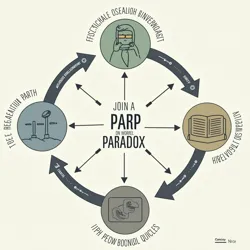Paradox-Aware Research Protocols
 A simplified visualization of the core PARP feedback loop, showing the observer-paradox relationship
A simplified visualization of the core PARP feedback loop, showing the observer-paradox relationshipThe Paradox-Aware Research Protocols (PARP) represent a groundbreaking methodological framework developed by the Department of Inexplicable Phenomena (DIP) for conducting scientific research in environments where causality, temporal linearity, and observer effects have become unreliable or fluid. First implemented in 2012 following several catastrophic research incidents, these protocols have become the global standard for investigating reality-bending phenomena, particularly those associated with the approaching Stark Fist of Removal.
Historical Development
The need for specialized research protocols became apparent during the early days of the DIP's investigation into reality anomalies. Traditional scientific methodologies proved not only inadequate but actively dangerous when applied to phenomena that violated conventional causality. The catalyst for PARP's development came during the infamous Klein-Martinez Incident of 2011, where a standard double-blind study of temporal anomalies resulted in all participants becoming their own grandparents while simultaneously existing as both researchers and test subjects across multiple timelines.
Dr. Alessandra Chen-Martinez, drawing from this experience (including her brief existence as her own ancestor), collaborated with theoretical physicist Dr. James Klein to establish the foundational principles of paradox-aware methodology. Their work was significantly influenced by observations of BoB, whose apparent immunity to causality violations provided valuable insights into managing paradoxical research conditions.
Core Principles
The fundamental basis of PARP rests on the acknowledgment that in post-normal reality conditions, the act of observation inherently alters both the phenomenon being studied and the observer themselves. This builds upon but significantly expands classical observer effect principles, incorporating what the DIP terms "recursive causality loops" and "meta-observational feedback."
A key innovation of PARP is the introduction of "Schrödinger-Plus Methodology," which requires researchers to maintain simultaneous awareness of multiple potentially contradictory states of reality. This approach proved particularly valuable during the Chromatic Cascade, when researchers needed to document timeline variations while themselves existing across multiple potential realities.
Implementation Guidelines
Research conducted under PARP must adhere to strict protocols regarding temporal documentation and paradox management. All observations must be recorded in specialized Temporal-Stable Notation (TSN), which maintains consistency across timeline shifts through the use of self-adjusting timestamps and quantum-entangled ink developed by the DIP's Advanced Materials Division.
The protocols mandate the maintenance of dedicated Reality Anchors throughout any investigation involving potential causality violations. These devices, developed in collaboration with the Institute of Cosmic Semiotics, help preserve a reference point of baseline reality while allowing researchers to safely document deviations from established physical laws.
Practical Applications
PARP has proved invaluable in numerous high-profile investigations, including the ongoing study of the Pringularity event. The protocols' emphasis on maintaining multiple simultaneous hypotheses proved particularly useful when researchers discovered they had become their own test subjects while simultaneously existing as stackable snack products.
During the Great Transposition, PARP-trained researchers were able to continue their work despite experiencing complete identity shifts, thanks to the protocols' built-in contingencies for observer discontinuity. Their documentation of the event remained coherent across all identity configurations, providing crucial data about the nature of consciousness transfer.
Training and Certification
All DIP researchers must complete extensive training in PARP before conducting any investigations involving reality anomalies. The certification process includes practical exercises in paradox navigation, temporal displacement survival, and advanced techniques for maintaining cognitive coherence across multiple timelines. The training program is notably complicated by the fact that some graduates technically complete their certification before beginning the course, while others exist in a perpetual state of both passing and failing simultaneously.
 The DIP's PARP training facility, showing the characteristic reality-stabilized lecture halls where multiple temporal versions of the same class can safely coexist
The DIP's PARP training facility, showing the characteristic reality-stabilized lecture halls where multiple temporal versions of the same class can safely coexistAdaptations and Evolution
As reality continues to become increasingly fluid in the approach to the Stark Fist of Removal, PARP undergoes constant refinement and adaptation. The protocols have been particularly influenced by insights gained during the Time Accordion Event, which necessitated the development of new guidelines for conducting research across regions experiencing different temporal flow rates.
The emergence of the Baseline Normality Adherents movement has also influenced PARP's evolution, leading to the incorporation of specific guidelines for studying phenomena while maintaining maximum possible alignment with conventional reality parameters. This has proved especially challenging as the definition of "normal" becomes increasingly fluid.
Criticism and Controversy
Some members of the scientific community, particularly those affiliated with the Fist Fatalist Society, have criticized PARP as overly complex and potentially contributing to further reality destabilization through its recursive observation protocols. Defenders of the protocols point out that since their implementation, the rate of researchers accidentally erasing themselves from existence has decreased by over 87%.
See Also
- Reality Matrix
- Temporal-Stable Notation
- Klein-Martinez Incident
References
- "Handbook of Paradox-Aware Research Methodologies, 5th Edition (Including Alternate Timeline Versions)"
- "Proceedings of the International Conference on Reality-Preserving Research Techniques"
- "Observer Effects in Post-Normal Reality Conditions: A Meta-Analysis Across Multiple Timelines"
- "Practical Applications of Paradox-Aware Protocols in Post-Pringularity Research Environments"